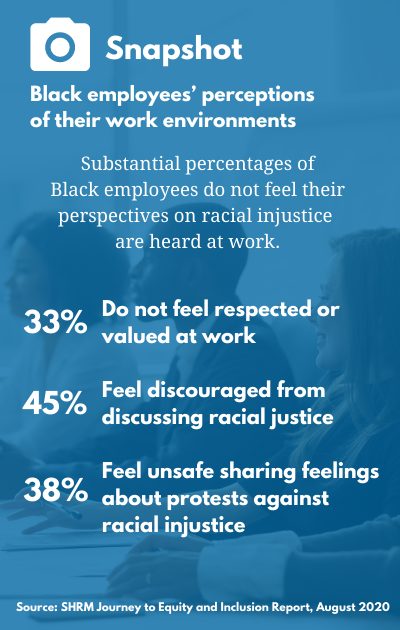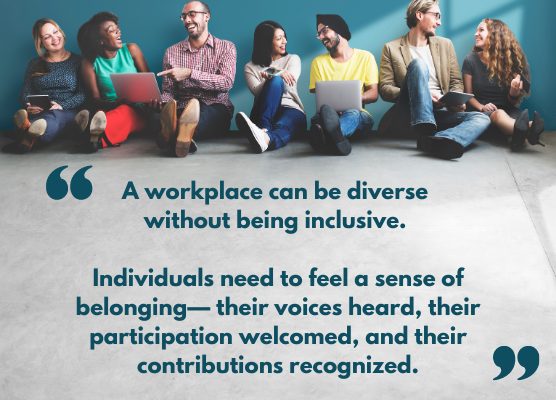Inclusivity and harmony: The battle against racism in the workplace
 In the name of maintaining a peaceful environment, employers traditionally have encouraged workers to leave politics and other sensitive issues at the door when entering the office. Recent events that have catapulted the topic of racism into the national spotlight, however, demand that companies pursue solutions rather than silence.
In the name of maintaining a peaceful environment, employers traditionally have encouraged workers to leave politics and other sensitive issues at the door when entering the office. Recent events that have catapulted the topic of racism into the national spotlight, however, demand that companies pursue solutions rather than silence.
“We are past the point where organizations can be insulated from the broader societal concerns,” says Hazel-Anne Johnson-Marcus, associate teaching professor and Director of the Human Resource Management Undergraduate Program, Rutgers School of Management and Labor Relations. “This current movement to address systemic racism demands action from organizations as they are one of the systems within which the effects of racism limit the opportunities of black Americans. The way to get to a peaceful workplace has to involve addressing the systemic issues of racism within the organization as well as the microaggressions that can be a part of the daily work lives of women and people of color within organizations.” To that end, here are some strategies:
Aim for a more diverse workforce from the start
Conscious effort to create a heterogeneous staff makes for a richer workplace culture. Examine recruitment efforts and hiring methods to ensure qualified candidates from a variety of backgrounds receive thoughtful consideration.
Know the difference between diversity and inclusivity
A workplace can be diverse without being inclusive. Individuals need to feel a sense of belonging—their voices heard, their participation welcomed, and their contributions recognized.
“Organizations that are less inclusive are more likely to experience tensions between employees,” Johnson-Marcus says. She notes, however, that even within some organizations that may have felt more inclusive a few weeks ago, black employees may be feeling less included today.
“This happens when their colleagues are silent because they are not comfortable talking about race,” she says. “If the organization does not have the in-house talent to address these issues, they should reach out to trained facilitators with expertise in the area of diversity, equity, and inclusion to help guide them through the process.”
Provide outlets for meaningful conversation
At the opposite end, some companies may experience heated, divisive conversations happening informally among employees. As with ice-breaking, setting up a more organized atmosphere may prove useful.
“Providing forums, such as panel discussions or team meetings, gives employees a safe, constructive place to have candid conversations, ask questions, share experiences, and learn from one another,” says executive coach and career strategist Elizabeth Koraca. “By giving employees the opportunity to lead conversations, managers foster a supportive environment.”
Throughout the discussions, encourage an open mind and respectful behavior. Management cannot allow harassment, hurtful comments, or pointed jokes in any setting.
Creating inclusivity groups composed of people passionate about fostering better relations also can reap benefits. Since people learn and grow when they mix and chat, such teams may host cultural celebrations, film screenings followed by discussion, and volunteer opportunities where employees bond while supporting a cause.
Realize, too, the value of less openly visible ways of hearing what’s on people’s minds. Anonymous surveys allow workers to express thoughts and opinions without fearing the judgement of others.
Likewise, let staff members know your door is always open for one-to-one discussions.
Do not feel you must have the answers
People tend to shy away from things that make them uncomfortable, and leaders are no exception. Recognize this obstacle, and work to overcome. Seek advice and support from other managers, HR, and members of your network confronting similar workplace scenarios. Getting a better handle on things before holding conversations with your own team promotes the confidence to try.
“Managers may face the challenge of not being educated on the issues we are facing today,” Koraca says. “They may not be subject matter experts on these issues, legislators or activists in our communities. It is important for managers to invest time to research, listen and learn from employees who may be impacted by the recent events. Managers may then be in a better position to find opportunities to support their teams.”
Let your employees guide you, too. Ask basic questions such as “How can I help?” and “What can be done to improve our workplace?” to start the ball rolling. Show curiosity, humility and the desire to understand. Great things happen by genuinely listening to people who long to be heard.








